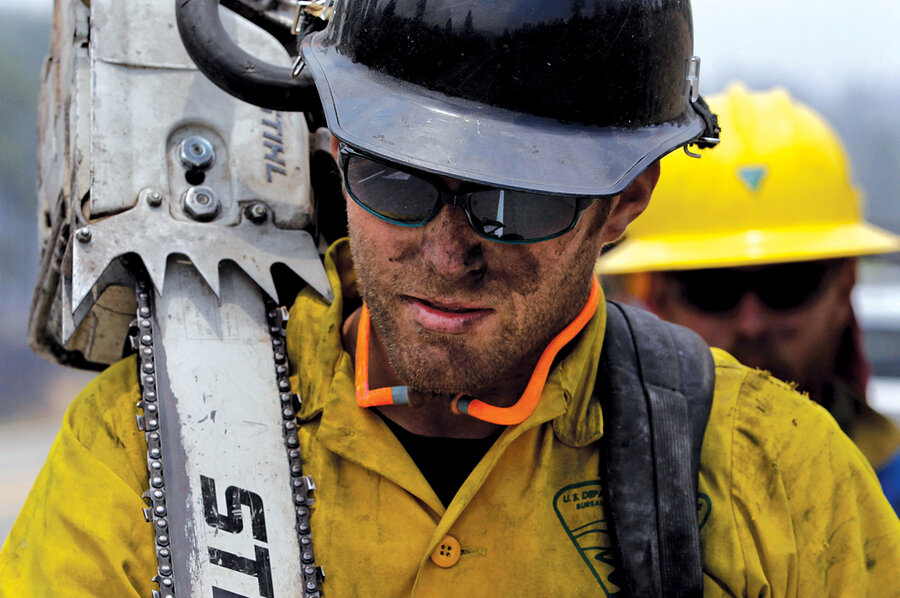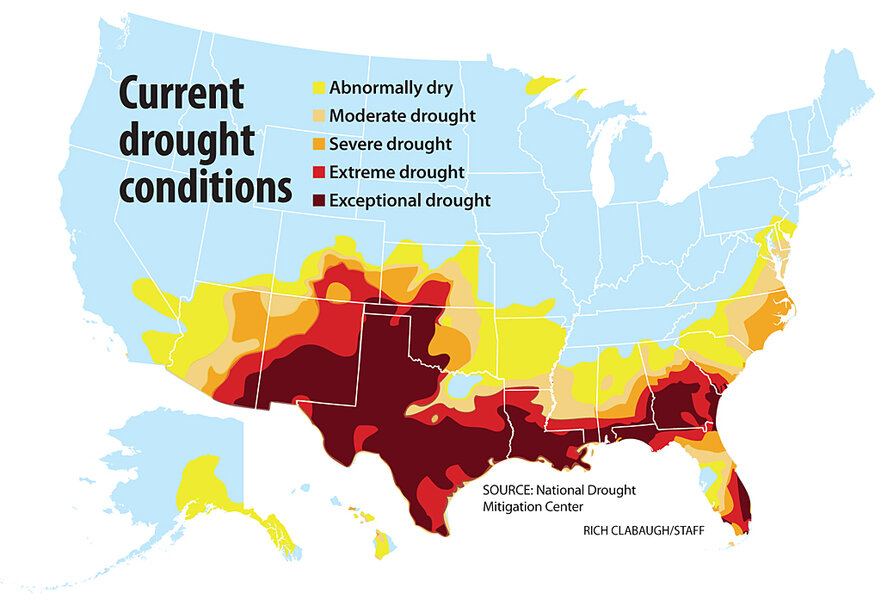Raging wildfires: Climate changes to blame for record season?
Loading...
The images are stark: soot-grimed firefighters steering bulldozers or wielding shovels to clear underbrush; curtains of orange flame tracing the contours of summits; aircraft dumping chemicals to slow a fire's progress.
Between Jan. 1 and early July of 2011, slightly more than 38,000 wildfires charred the landscape in the United States at a record pace. So far this year, wildfires have consumed just under 4.9 million acres of forest and grassland, a cumulative expanse the size of New Jersey.
That's 1 million more acres than fires consumed during the same period in 2006, which saw a record 9.9 million acres burned for the entire year.
Beyond the numbers, this year's fires may provide the first large-scale tests of the effectiveness of projects undertaken over the past decade to help forests survive wildfires, several specialists say.
The West's forests are adapted to deal with certain types of wildfires, researchers note. But since the mid-1980s, they add, some of these forests have experienced an increasing number of fires to which they are not well adapted.
Many researchers trace this shift in part to climate change. Thus, restoration efforts focus not only on how to reestablish fire regimes that these forests can best endure, but also on how to do this in the face of an already-changing climate.
The alternative: large, intense fires likely to trigger long-term shifts in the makeup of vegetation, with as-yet-unknown effects on ecosystems and watersheds.
"This is the year we will be able to go in and complete the experiment," says Melissa Savage, professor emeritus of geography at the University of California, Los Angeles, and a trustee of the Valles Caldera National Preserve, west of Santa Fe, N.M. "So much acreage burned, and it burned over so many restoration treatments, that we will get the answer this year" regarding which treatments worked, which didn't, and why, she says.
In 2000, for instance, the US began thinning forests where firefighting efforts over the preceding century had allowed smaller trees and shrubs to build up beyond normal levels. Called the National Fire Plan, the program targeted some 42,500 square miles of forest, especially where forests and communities meet.
Those efforts, and others, are indeed undergoing a big test this year. In Georgia, firefighters are battling a 295,000-acre blaze in the Okefenokee National Wildlife Refuge. The fire began April 30. And Texas, which begins its tally each Nov. 15, has seen nearly 14,000 fires burn a record 3.2 million acres so far this season.
Meanwhile, firefighters in New Mexico are struggling to contain the Las Conchas fire, which began June 26 and has burned nearly 148,000 acres. In Arizona, the Wallow fire is more than 95 percent contained. That blaze began May 29 and has blackened 538,000 acres, including 15,000 acres in New Mexico. Both fires set state records.
The number of acres burned in 2011 could surpass the record set by wildfires in 2006, says Roberta D'Amico, an information specialist with the National Interagency Fire Center in Boise, Idaho. But, she cautions, much will depend on what happens in other parts of the West in July and August.
Although heavy snows this past winter as well as spring snow and rain in the Northwest and northern Rocky Mountains have triggered flooding along rivers, they also have kept forests moist, reducing the risk of large, intense wildfires.
"I'm sitting here in Idaho, and it's unusual for our mountains to be green this time of year," Ms. D'Amico says.
Several factors have contributed to this year's remarkable fire season, explains Laura McCarthy, senior policy adviser for fire and forest restoration at the Nature Conservancy office in Santa Fe, N.M.
Fire policies for most of the 20th century focused on snuffing out every blaze. This reduced the frequency of ground-hugging, low-intensity fires that would clear the forest floors of shrubs, small trees, and ground litter. Without those fires, forests became more densely populated with trees and shrubs of varying heights – ladders for flames to reach the pitch-rich crowns of mature trees.
Despite efforts to restore forests to more-natural fire regimes, "about 80 percent of our forests in the Lower 48 states ... are in either a moderately or severely degraded condition, which means they're experiencing too much, too little, or the wrong kind of fire," Ms. McCarthy says.
Moreover, the climate change that scientists have documented in the West has extended the fire season.
Shorter-term climate conditions also have contributed to this year's fires, according to Martin Hoerling, a researcher at the National Oceanic and Atmospheric Administration's Earth System Research Laboratory in Boulder, Colo. La Niña conditions in the tropical Pacific from late last summer through this spring pushed the average storm tracks across North America farther north than usual, he explains.
Thus, the southern tier – from Arizona through northern Florida and Georgia – has been experiencing droughts ranging from extreme to exceptional (see map).
The onset of the hurricane season in the Gulf and the North American monsoon season in the Southwest may ease things somewhat, Dr. Hoerling says.
Beyond climate issues are land-use practices, McCarthy adds. Where logging has occurred, smaller trees more vulnerable to fire are left behind. Where livestock have grazed, the ground is denuded of the grasses and "fine fuels" that could sustain useful low-level fires. And urban encroachment has put more people into contact with forests, increasing the likelihood of fires set directly or indirectly by humans.
In the Southwest, where ponderosa forests play a vital role economically and ecologically, intense crown fires such as the Wallow stand a fair chance of altering the landscape for decades, if not longer, researchers say.
This year's fires could also have greenhouse-gas implications. A wildfire destroyed 26,000 acres of ponderosa pine in the Coconino National Forest near Flagstaff, Ariz., in 1996. Over the following decade, the burned area turned into a net source of carbon dioxide for the atmosphere, researchers from Northern Arizona University found.
With so much at stake, scientists are trying to figure out the right blend of techniques and the right treatment intervals for restoring more-natural fire regimes to ponderosa forests and beyond.
A team led by Northern Arizona University's Peter Fulé used data from a forest restoration site near the Grand Canyon to model the effects of potential treatments over the next 100 years.
Under a steady climate, the team found, forests could retain their resilience to wildfires if low-level fires were set every five years or so. With a warmer climate, they found that prescribed burns needed to take place only every 20 years, on average; vegetation's growth slows as the climate warms.






